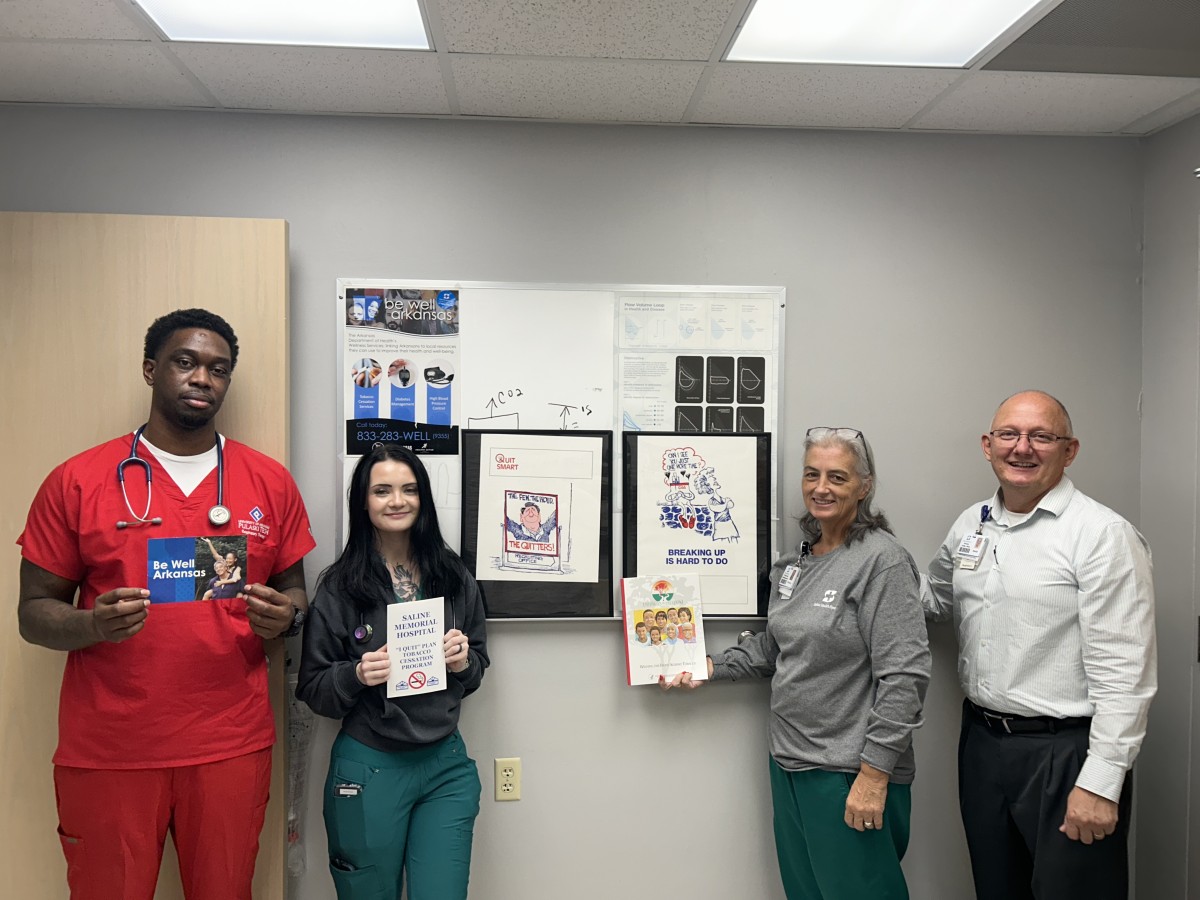Smoking Cessation – Your Journey to a Healthier Life
November 14, 2024

By: David Gibson, Cardiopulmonary Director at Saline Memorial Hospital
If you smoke cigarettes, then you’re probably aware of the dangers they pose to your health. Maybe you’ve thought about quitting. According to the Centers for Disease Control (CDC), more than two thirds of smokers express a desire to quit, and more than half have tried to quit within the past year.[1]
Unfortunately, when it comes to smoking, quitting is easier said than done. Cigarettes are habit-forming and highly addictive, which is why many smokers fail to quit the first time they try. The good news is that it’s never too late to stop smoking – no matter your age, quitting today can improve your health and wellbeing for the years ahead.
November is Lung Cancer Awareness Month. Whether you’re a smoker yourself or you’re looking to help someone you know, here’s what you need to know about smoking cessation.
Why should I quit smoking?
Cigarette smoking carries many health risks. People who smoke regularly are more likely to develop cancer, heart disease, type 2 diabetes, and lung problems such as chronic obstructive pulmonary disease (COPD). Overall, smoking and exposure to secondhand smoke causes more than 480,000 deaths in the United States each year.[2]
Quitting smoking, on the other hand, comes with a variety of benefits that can last the rest of your life. People who quit smoking often report that food tastes better and they can breathe more easily. These people are also less likely to experience high blood pressure, a heart attack or a stroke.[3]
How can I quit smoking?
Once you’ve developed a smoking habit, it can be hard to stop. Your brain has gotten used to the nicotine in cigarettes, and it will send you the message that you need more of it. But with practice, you can learn to resist these urges. Set yourself up for success by doing the following:
Make a plan. Giving up smoking is a major commitment, and one that can dramatically improve your health if followed through.
Avoid triggers. Where do you normally start smoking? Are there certain situations or emotions that prompt you to pull out a cigarette? Recognize what your triggers are, and make a plan to avoid them or to get through them without nicotine.
Distract yourself. If you feel yourself craving a cigarette, don’t give in. Instead, find something else to do. Get up from your chair. Go for a jog. Clean the house. Physical activity is a great way to get your mind off smoking and to keep yourself healthy.
Find a substitute. Some smokers miss the feeling of a cigarette in their mouth. If you experience this, try chewing something else instead, such as gum, toothpicks or hard candy. You can also occupy your hands with a stress ball or a doodle pad.
Try nicotine replacements. The nicotine found in cigarettes is highly addictive – trying to quit all at once can lead to feelings of withdrawal. Nicotine replacement products such as patches, gums and lozenges can supply your body with a smaller dose of nicotine, minus the harmful chemicals found in cigarettes. This lessens your withdrawal symptoms, which makes quitting easier.
Don’t give up. It may be tempting to “just have one” cigarette. But the first cigarette often leads to more, and then it’s easy to slip back into the habit of smoking. Remember: what you’re feeling will pass. If not acted upon, the urge to smoke will usually dissolve within a few minutes. As you go longer without smoking, you will experience those urges less and less frequently.
What resources are available?
If you’ve decided to quit smoking, you’re not alone. The whole world wants you to succeed, and plenty of resources exist for people who are in exactly your situation. When you feel like you need a helping hand, you can find support in the following places:
Friends and family. Telling people who you love and trust about your plan to quit is a great way to hold yourself accountable and build a network of support. If you know someone else who smokes, they may even want to join you in quitting.
Doctors. As you begin your transition to a smoke-free lifestyle, your primary care physician is a good source of day-to-day medical advice. They can help you recognize common pitfalls and understand what to expect based on your unique medical situation. If appropriate, your doctor can also prescribe certain medications that aid in smoking cessation. You can find a primary care provider by visiting SalineMemorial.org.
Quitlines. If you don’t have time to schedule a doctor’s appointment, quitlines can connect you with professional help at a moment’s notice. These telephone hotlines are available throughout the United States in a variety of languages, and are completely free of charge. When you call a quitline, a trained “quit coach” will ask questions about your smoking habits, offer advice and encouragement, and help you create a cessation plan.
English: Call 1-800-QUIT-NOW (1-800-784-8669)
Spanish: Call 1-855-DÉJELO-YA (1-855-335-3569)
The Internet. Many nonprofit organizations are dedicated to helping smokers find the strength to quit, including the Centers for Disease Control (CDC), the American Lung Association, and the Substance Abuse and Mental Health Services Administration (SAMHSA). These organizations offer a variety of online resources, such as educational guides, quit plans, and virtual or in-person support groups.
For more information about quitting tobacco use, visit smokefree.gov. or talk to your healthcare provider. If you need a healthcare provider, visit our Find a Provider tool on our website or call 501.387.0163.
If you are at high risk for lung cancer, you may benefit from a lung cancer screening called low-dose CT scan. Learn more at SalineMemorial.org/LungCancerScreening.
[1] VanFrank B, Malarcher A, Cornelius ME, Schecter A, Jamal A, Tynan M. Adult Smoking Cessation — United States, 2022. MMWR Morb Mortal Wkly Rep 2024;73:633-641.
[2] https://www.ncbi.nlm.nih.gov/books/NBK179276/pdf/Bookshelf_NBK179276.pdf
[3] https://www.cancer.org/cancer/risk-prevention/tobacco/benefits-of-quitting-smoking-over-time.html
